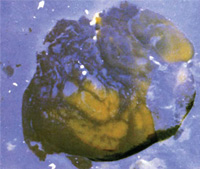
Rotten eggs

Description
Bacterial or fungal contamination of the egg can produce black, red or green rots. The egg looks and smells putrid when broken out.
Incidence
Under conditions of good management, the incidence of rotten eggs is very low, rising slightly in summer. Such eggs must be eliminated during grading, as they have such a detrimental effect on product image. It is unacceptable for even one rotten egg to reach the consumer.
| Cause | Control |
|---|---|
| Faecal contamination | Follow relevant food safety handling and processing guidelines and requirements — details vary in different countries. |
| Improper washing procedures | Keep cage floors, collection belts and nest boxes free of droppings and egg contents. Brush roll-out trays frequently to keep them clean. Reject extremely dirty eggs. Wash dirty eggs only. The temperature of water used for washing should be 41—44 °C. Use only a recommended, registered egg-washing detergentsanitiser combination at the correct concentration. For bubble-type washers, change the washing solution every 3 to 5 baskets; otherwise, change the solution every 4 hours. Dry and cool eggs immediately after washing. Thoroughly clean and sanitise washing equipment daily, using a different detergent-sanitiser mixture from that used to clean eggs. Do not wipe eggs with a damp cloth or rub them with abrasives. |
| High storage temperature and humidity | Reduce shed temperatures in summer. Collect eggs at least twice a day and even more often in summer. |
| Old eggs | As soon as possible after collection, store eggs in a coolroom at a temperature of 12 to 15 °C and a relative humidity of 70 to 80%. Make sure that eggs are not trapped in cages. Such eggs may eventually roll out and be collected when they are stale. If layers are kept on deep litter, collect eggs only from regularly used nests. Eggs discovered elsewhere may not be fresh. Reject any eggs whose freshness is in doubt. |
| Infection in a hen’s oviduct | Such infections are rare. If they occur, make every effort to identify and cull the affected birds. |
COPYRIGHT NOTICE: OPTIMUM EGG QUALITY - A PRACTICAL APPROACH
© The State of Queensland, Australia (through its Department of Primary Industries and Fisheries) and DSM Nutritional Products Ltd., 2007. No part of this publication may be reproduced, copied or transmitted save with prior written permission of Director, Intellectual Property Commercialisation Unit, Department of Primary Industries and Fisheries, GPO Box 46 Brisbane, Queensland, Australia 4001, and DSM Nutritional Products Ltd.
© The State of Queensland, Australia (through its Department of Primary Industries and Fisheries) and DSM Nutritional Products Ltd., 2007. No part of this publication may be reproduced, copied or transmitted save with prior written permission of Director, Intellectual Property Commercialisation Unit, Department of Primary Industries and Fisheries, GPO Box 46 Brisbane, Queensland, Australia 4001, and DSM Nutritional Products Ltd.






